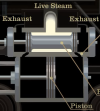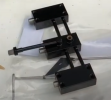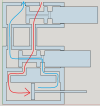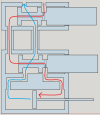DannyTheElfman
Registered
Hey everyone,
Sorry a bit of a silly question. I'm well familiar with the workings of locomotives with standard valve gear. Every steam valve I've seen has got a single steam inlet, and two exhaust ports. As in the diagram below.

Yet seemingly on our Accucraft locos, they make do with a single steam inlet, and a single exhaust port, leaving me wondering where the gasses are disposed of on the side of the cylinder without an exhaust? You can see below, only two ports on the valve gear, where is the third?

I've had a bit of a think, and the only way I can make this work in my head, is if the valve has a hollow centre and allows gasses to pass through, effectively allowing the cylinder to exhaust through both the inlet and exhaust depending on where it is in the cycle and where the reverser is set. I have mapped out my thoughts below. The central steam chest is placed at the top of the diagrams, with the valve gear and cylinder below.


Is this correct or am I miles off the mark? I have no reason to actually need to know how it works. Just pure curiosity!
Many thanks
Dan
Sorry a bit of a silly question. I'm well familiar with the workings of locomotives with standard valve gear. Every steam valve I've seen has got a single steam inlet, and two exhaust ports. As in the diagram below.

Yet seemingly on our Accucraft locos, they make do with a single steam inlet, and a single exhaust port, leaving me wondering where the gasses are disposed of on the side of the cylinder without an exhaust? You can see below, only two ports on the valve gear, where is the third?

I've had a bit of a think, and the only way I can make this work in my head, is if the valve has a hollow centre and allows gasses to pass through, effectively allowing the cylinder to exhaust through both the inlet and exhaust depending on where it is in the cycle and where the reverser is set. I have mapped out my thoughts below. The central steam chest is placed at the top of the diagrams, with the valve gear and cylinder below.


Is this correct or am I miles off the mark? I have no reason to actually need to know how it works. Just pure curiosity!
Many thanks
Dan
